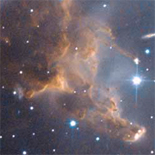
Star Forming Region (NASA/ESA)
Astronomy 393F - Fall 2009
SURVEY OF INTERSTELLAR MEDIUM
MWF 11:00-12:00 · RLM 15.216B · Unique No. 49605
Professor
Courses - Fall '09 | Course Website
|
|
|
Overview
The interstellar medium plays an important role in the evolution and appearance of galaxies.
It is the source of material for star formation and a sink for mass lost during stellar evolution.
It also processes much of the radiative and mechanical energy emitted by stars and supernovae.
In this course, we will describe the important features of the ISM, discuss the relevant physics, and
try to understand how interstellar matter behaves. We will take a broad definition of the ISM (everything
outside of the photospheres of stars and planets). With this definition, the physical processes in the
ISM are applicable to almost all areas of astrophysics.
Course Setup
The course will be a mixture of lecture and discussion. The last class day for each chapter of the text
will concentrate on questions from me or you, with 2-3 of you designated as experts who will be prepared
to ask and answer questions.
Deliverables
Problem Sets: There will be short problem sets every 2-3 weeks. (30% of final grade)
Hour Exams: There will be hour exams on Sep 25, Oct 23, and Nov 20. (each 10% of final grade)
Final Exam: There will be an oral final exam for each student. Exams will take place during the last week of classes. Exams will last 30 minutes. You need to arrange for a neutral senior party to be present at the exam. This can be your adviser or another professor or research scientist. (30% of final grade)
Participation: I am counting on you to keep up with the reading and to take an active part in the discussion. In particular when you are taking a turn as an "expert reader", you need to be prepared (10% of final grade).
Text
The Physics and Chemistry of the Interstellar Medium, by A.G.G.M. Tielens, 2005, Cambridge UP. This book assumes
more knowledge of spectroscopy than most of you are likely to have. To fill in the gap, we will start with a summary
of atomic and molecular structure and spectra. Chapters 9-11 of Radiative Processes in Astrophysics, by Rybicki &
Lightman will be the text for this part of the course.